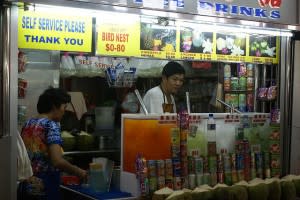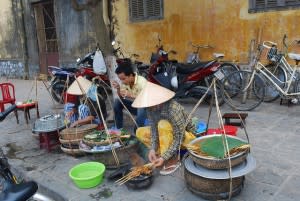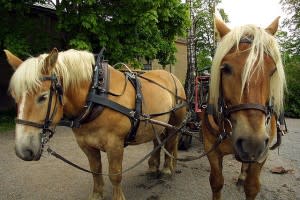How Much Do Hawkers Really Make?
Yesterday I discovered two great perks of working for MoneySmart: First, I have a convenient excuse to annoy people with endlessly amusing (to me) questions. Second, it means not having to be a hawker. See, at my favourite stall yesterday, I took the opportunity to investigate an old mystery: how much do hawkers really make? The answer will make you weep.

"I'm sorry, how much did you say my chicken rice should be? I was busy laughing hysterically."
My contact for this story is Lawrence. I used to work with him in hell the restaurant business. He’s been in the hawker business for 10 years, so he probably sweats chicken essence and bleeds Red Bull. In addition, much thanks to the owners of my favourite store (see the bottom of the article) for their added help.
What’s the Income?

"This job is not about the money. It's about…oh, wait. It IS about the money."
Lawrence says the hawker’s income is heavily dependent on food or location. However, the average hawker:
“…will make maybe $2500 or $3000 a month, minus overheads.”
Well that isn’t so bad. Except:
“That’s assuming you work day and night. At least 10 hours a day, no weekend, one public holiday. No bonus, no benefits. If for some reason you can’t run the stall, you’re sick or something, the loss is very big. For hawkers, MC is very expensive.”
Oh. Well that sucks then. But are there exceptions?
Of Food and Profit
“Yes, there are exceptions,” Lawrence says, “it depends on what you’re serving. If you sell chicken rice, you will make maybe 45 cents per plate. Noodles you can make more, about one dollar per plate. I know that some noodle stores make $5000 – $7000 a month.
You can justify selling one plate of noodles for $3 – $4.50 quite easily. But if you sell rice people tend to expect $1.20 – $2.50 per plate.

Cheat mode for hawkers.
It’s also about the speed. How many customers can you serve in one hour? With chicken rice you have to chop the chicken, cook the rice, prepare the vegetables, pour the chilli, put the garlic and black sauce, and wrap up the food. Usually I do 70 packets an hour. My best is 125 packets an hour. Maybe if I sell noodles, I might be able to do twice as much?”
Rental Woes
Lawrence thinks the story of the rich chicken rice hawker, who drives home in a BMW and wears a Rolex, wasn’t just a myth. It was probably true, during the golden years:
“If you’re talking about 20 years ago, it was still possible. For the first generation hawkers, their stall rental is very low.”
Lawrence refers to the Hardship Scheme in the 90′s. This was when resettled hawkers were given government assistance with their rent. The stall rental for these “first generation” hawkers can be as low as $200 a month.

Americans: "Charming". Europeans: "Exotic." Singaporeans: "Do they make more than me?"
“But that scheme…no more already. Now if a second generation guy wants to take over, the rent is a lot higher. Places like here (refers to Bedok South) can be $500 – $700 a month. But even that is not so bad. I can tell you a lot of hawkers pay $2000 – $4000 for a stall.”
What the…?
“Because stall holders who have a good location will sublet. So if someone has a good location, maybe he can pay the $700 to NEA, but then he will rent the stall to someone else for $2000 – $4000. Different location, different price. You want to see the ones that cost $4000 plus, you go to places like Holland Village.”
But is that even legal?
“I don’t know, but there’s not much choice. You need a good location. In a good location you can sell all the way until night time. But in a place like this, look around lah.”
Lawrence indicated the closed stores at Bedok South market. It was only 3.30 pm.
Location and Risk
“This work is very risky because the location is so sensitive,” Lawrence tells me. “Hawkers depend on four main things to be nearby: factories, schools, shopping centre, and residential. Sometimes you’ve been in one place for many years, but then there’s upgrading or relocation.

"So how would you describe your customers' purchasing power?"
If they change the location of the school or factory, or it’s upgrading, your revenue can drop by more than half. If there’s upgrading in your (hawker) centre, it can drop by around 30 percent. And if you change your own location, you must build up your customer base all over again.”
But what about food quality? If the food is good people will slavishly follow them around right?
“Some will. But will you really drive to Jurong or Pasir Ris, from wherever you are, just to eat chicken rice or wanton mee?”
Stall Assistants
“Last time we can pay stall assistants less than $1000,” Lawrence says, “today, if you pay $1200, it’s for them to just stand at the front of the store and pack chilli or collect money. If you want them to walk around, deliver food, most of them charge $1500 – $1700.”
Supply Issues
I asked about the rising supply costs, and the impact it was making. Lawrence shrugs this off as a long standing issue. He says the formula is:
“Six months good, three months bad, three months unpredictable. Usually it’s that supply pattern every year. When the supply costs go up we would rather absorb it then up our own price. I don’t want to lose customers. Later on, the supply cost will drop again; the good months will make up for the bad ones.”

"Yeah there's a rice shortage. For real. We don't just make up these price hikes."
So Can a Hawker Still Get Rich?
“A lot of hawkers don’t get past $3000 a month. If you can make $7000 a month, I will say you are very successful already. But there’s maybe one way to get rich.”
The trick, Lawrence says, is to invest in multiple stores.
“You need to find people you can trust, combined with good locations, combined with the knowledge of handling different suppliers. You must run multiple stores to really make money.
But you have to keep working, rotate yourself between the stores every few months. In this business you can never be a towkay (boss) who just sits back and collects money. You must know things like how fast the food can be prepared, or how many helpers are really necessary. Maybe if you can run five or six stalls or, you might retire rich.”

Computer generated depiction of "best physique for a hawker".
So the next time your hawker ups the price by 50 cents, think before complaining. Cut them some slack.
Image Credits:
British Council Singapore, Alex.ch, Avlxyz (Third Image), Avlxyz (Fourth Image), Avlxyz (Thumbnail), Ssedro, IRRI Images, Jakko Hakulinen
Got any questions about the hawker business? Comment and I’ll try to answer! Digg Digg
Get more Personal Finance tips and tricks on www.MoneySmart.sg
Click to Compare Singapore Home Loans, Car Insurance and Credit Cards on our other sites.
More From MoneySmart

